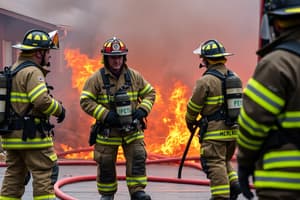Podcast
Questions and Answers
What is a primary consideration when developing a rotation plan for fire companies during an overhaul?
What is a primary consideration when developing a rotation plan for fire companies during an overhaul?
- Companies with low levels of activity should be selected for rotation. (correct)
- Companies with high activity levels should be prioritized for rotation.
- All nearby companies should be used to ensure quick response.
- All companies should participate regardless of their previous activity.
Which of the following criteria is NOT mentioned as a factor when determining the deployment of fire companies?
Which of the following criteria is NOT mentioned as a factor when determining the deployment of fire companies?
- Assessment of ALS and BLS coverage needs.
- Experience and training of personnel on duty. (correct)
- Time of day and travel distances.
- Substantial participation duration at the incident.
Who collaborates with the Incident Commander to determine the overhaul deployment criteria?
Who collaborates with the Incident Commander to determine the overhaul deployment criteria?
- The Emergency Medical Technician Unit.
- The Dispatch Center. (correct)
- The National Fire Commission.
- The Fire Chief.
What is the implication of selecting multiple units from the same geographic area?
What is the implication of selecting multiple units from the same geographic area?
In what situation may exceptions to the deployment criteria be made?
In what situation may exceptions to the deployment criteria be made?
What should be done if an outlying company is selected for rotation?
What should be done if an outlying company is selected for rotation?
What factors should be taken into account when notifying companies about their deployment?
What factors should be taken into account when notifying companies about their deployment?
Which of the following is a critical factor that should be considered if it affects deployment operations?
Which of the following is a critical factor that should be considered if it affects deployment operations?
Flashcards are hidden until you start studying
Study Notes
Incident Commander and Overhaul Operations
- Incident Commander can request fire companies for extended overhaul or standby after large-scale fire incidents.
- Dispatch Center collaborates with the Incident Commander or Planning Section to establish several key factors, including duration and resource allocation.
Overhaul Planning Criteria
- Approximate duration of the overhaul period must be determined.
- The number of units required for each rotation and the time interval for unit rotation is established during planning.
- Specific equipment needs for the incident are identified as part of the resource planning.
Deployment Strategy
- Companies engaged for a significant time at the fire incident are excluded from the rotation list to prevent fatigue.
- Units showing high levels of activity during the shift are generally not placed on the rotation list unless necessary.
- A historical review of units is essential to ensure that companies with minimal activity are prioritized for rotation.
Coverage Considerations
- Advanced Life Support (ALS) and Basic Life Support (BLS) needs must be assessed to ensure adequate regional response capability.
- Avoid deploying multiple units from the same geographic area to ensure a diverse coverage across regions.
Notification Protocol
- Companies chosen for extended overhaul will receive advance notification whenever possible.
- Notifications will detail response time, duration of assignment, and information on who will provide relief.
- Critical factors such as time of day and travel distances are considered in transportation logistics.
Rotation and Coverage Management
- Adaptive response units should cover for outlying companies selected for rotation if they weren't used in the recent incident.
- If no adaptive response unit is available or does not meet specific criteria, outlying units should only be used when absolutely necessary.
- Efforts will be made to adhere closely to established criteria for overhaul rotation, with exceptions made during periods of high demand to ensure adequate regional coverage.
Regular Deployment Process
- The deployment of fire companies for overhaul should be an integrated element of the Dispatch and Deployment Section's regular operational procedures.
Studying That Suits You
Use AI to generate personalized quizzes and flashcards to suit your learning preferences.




